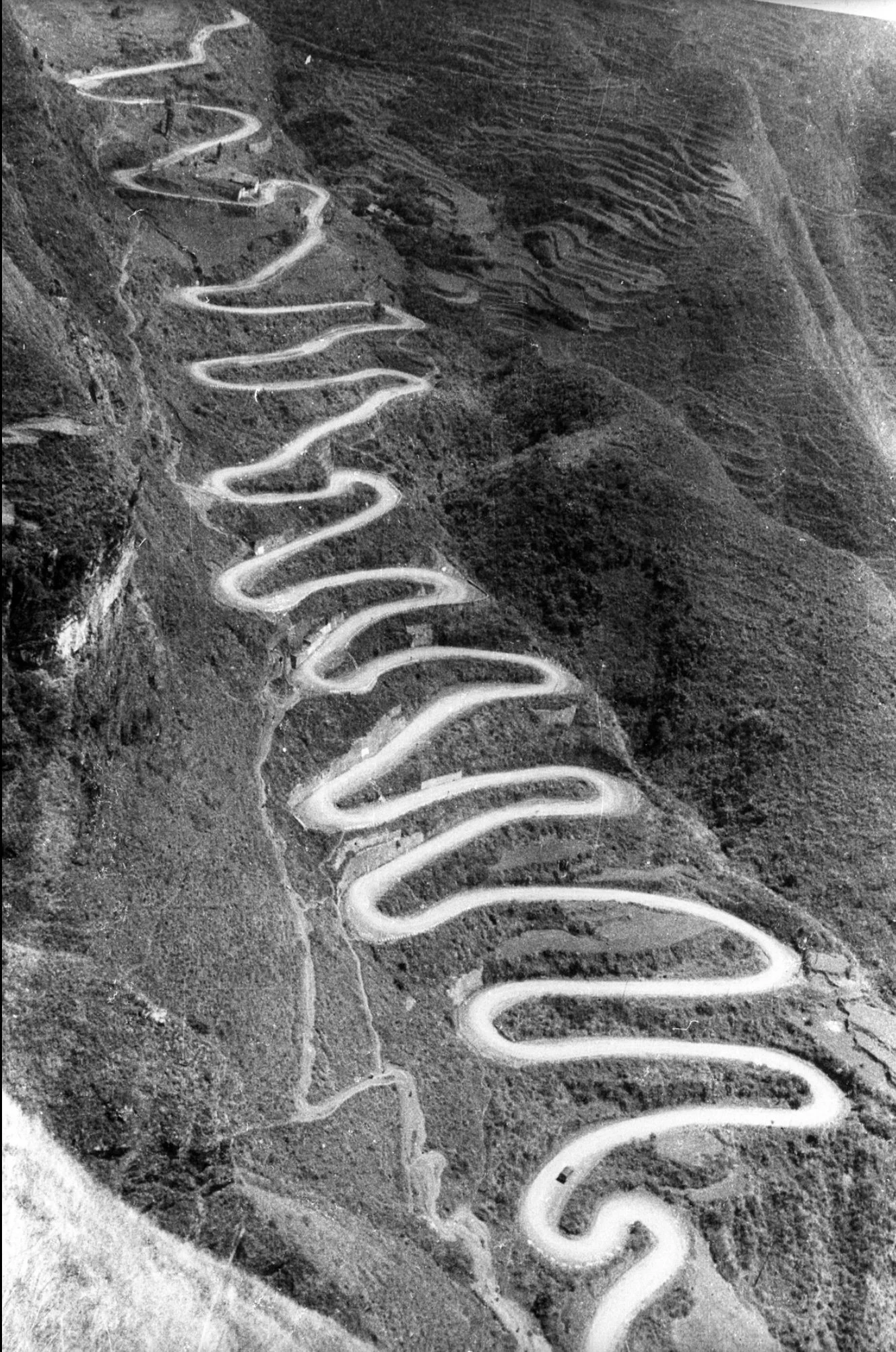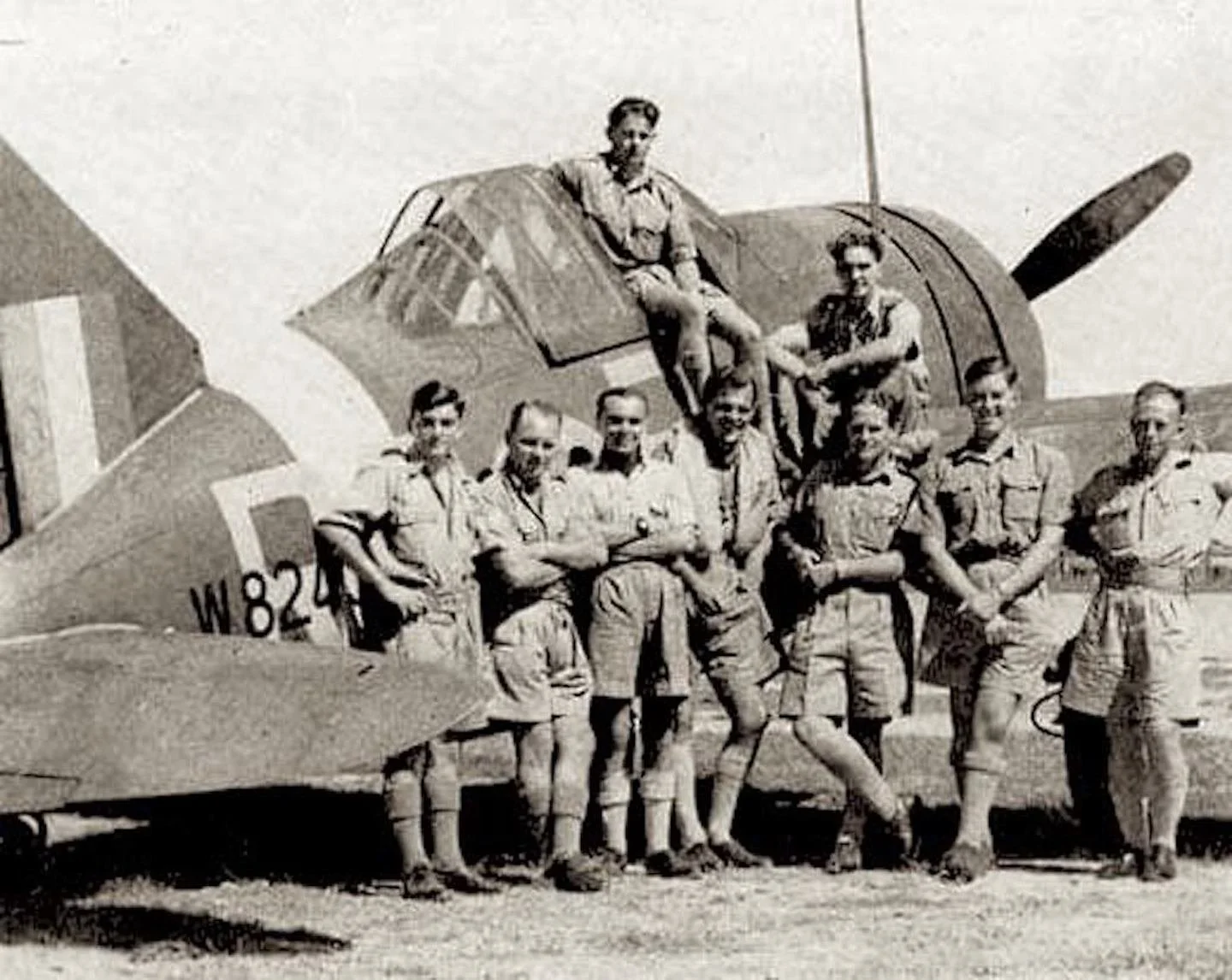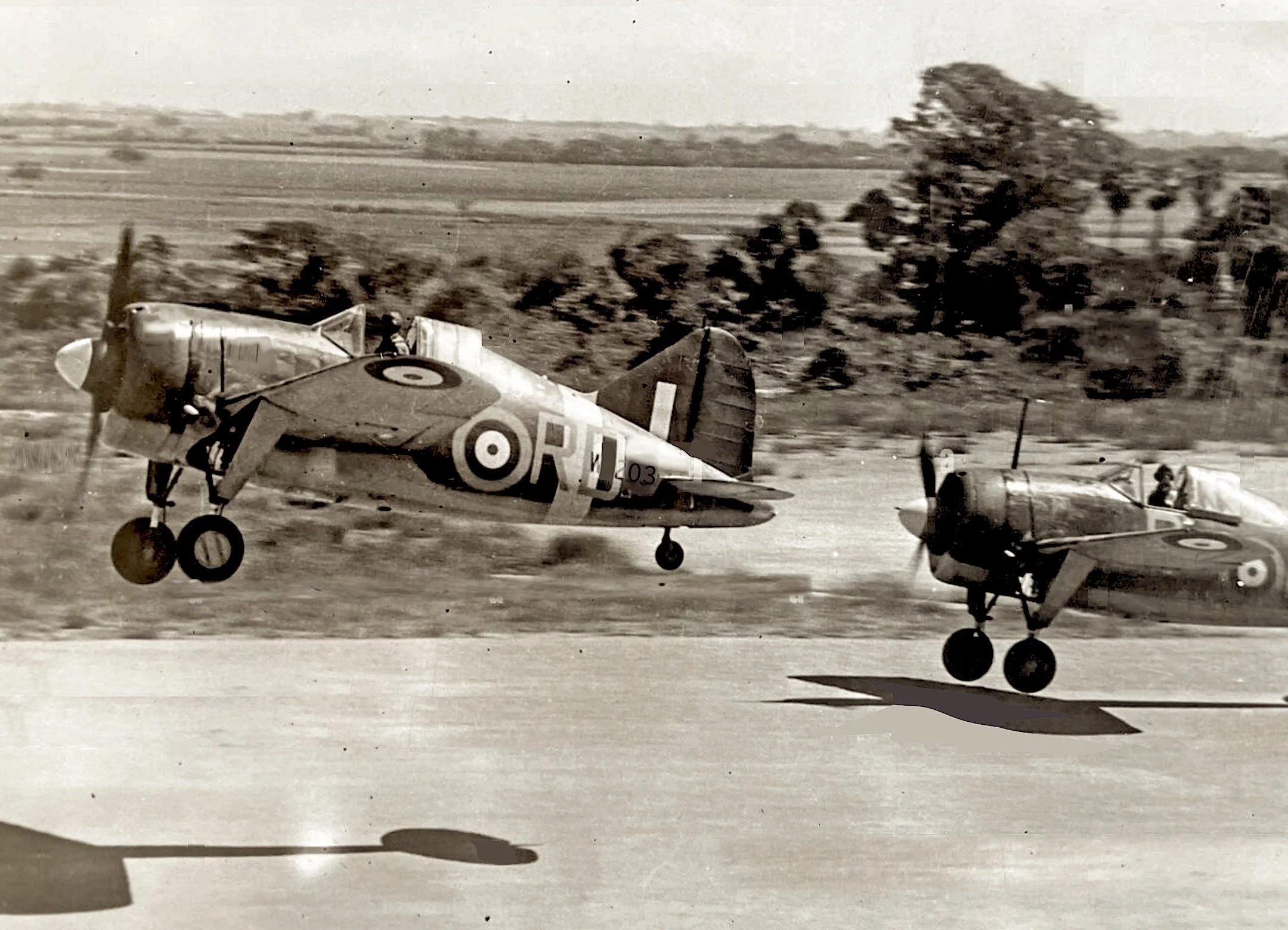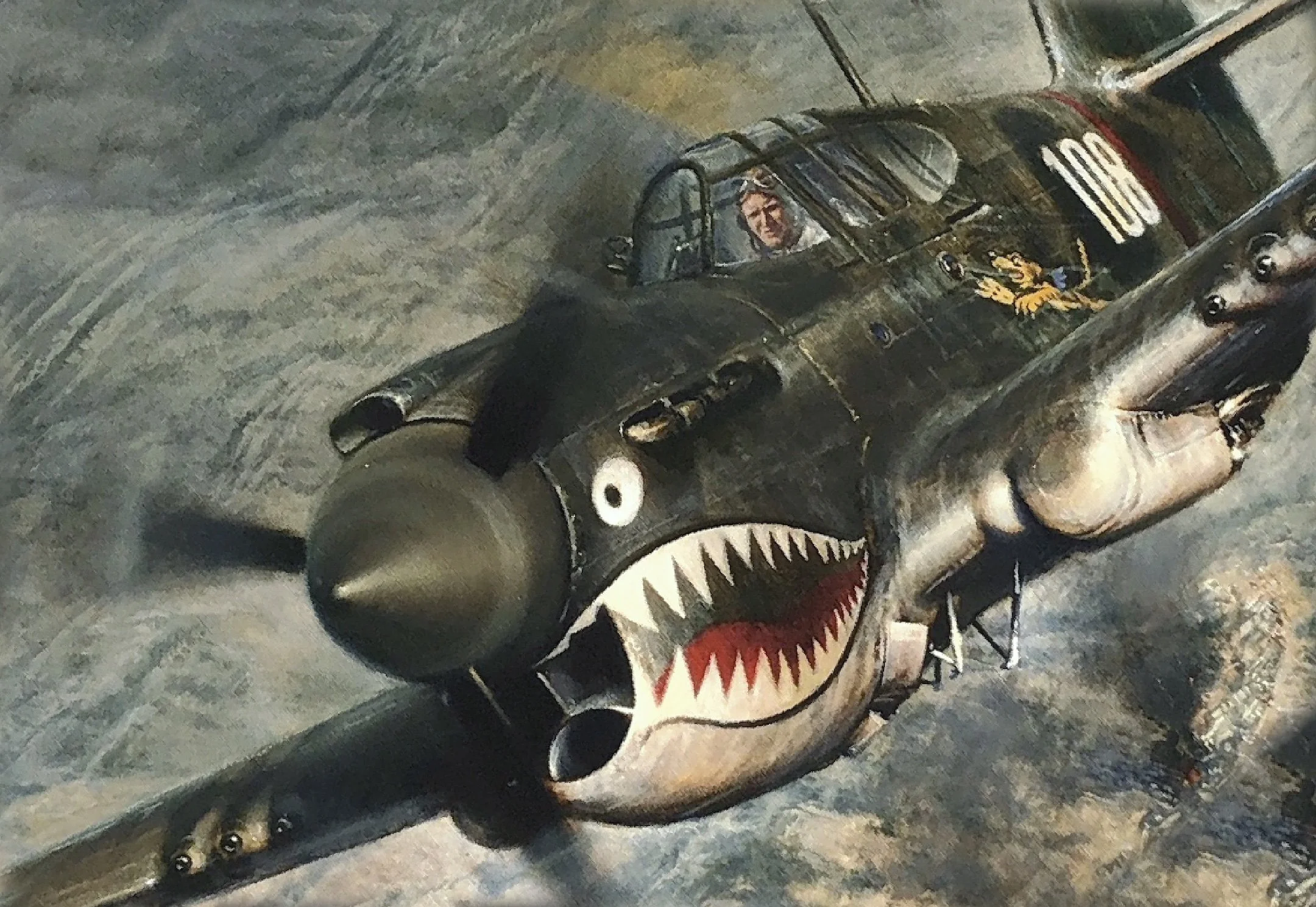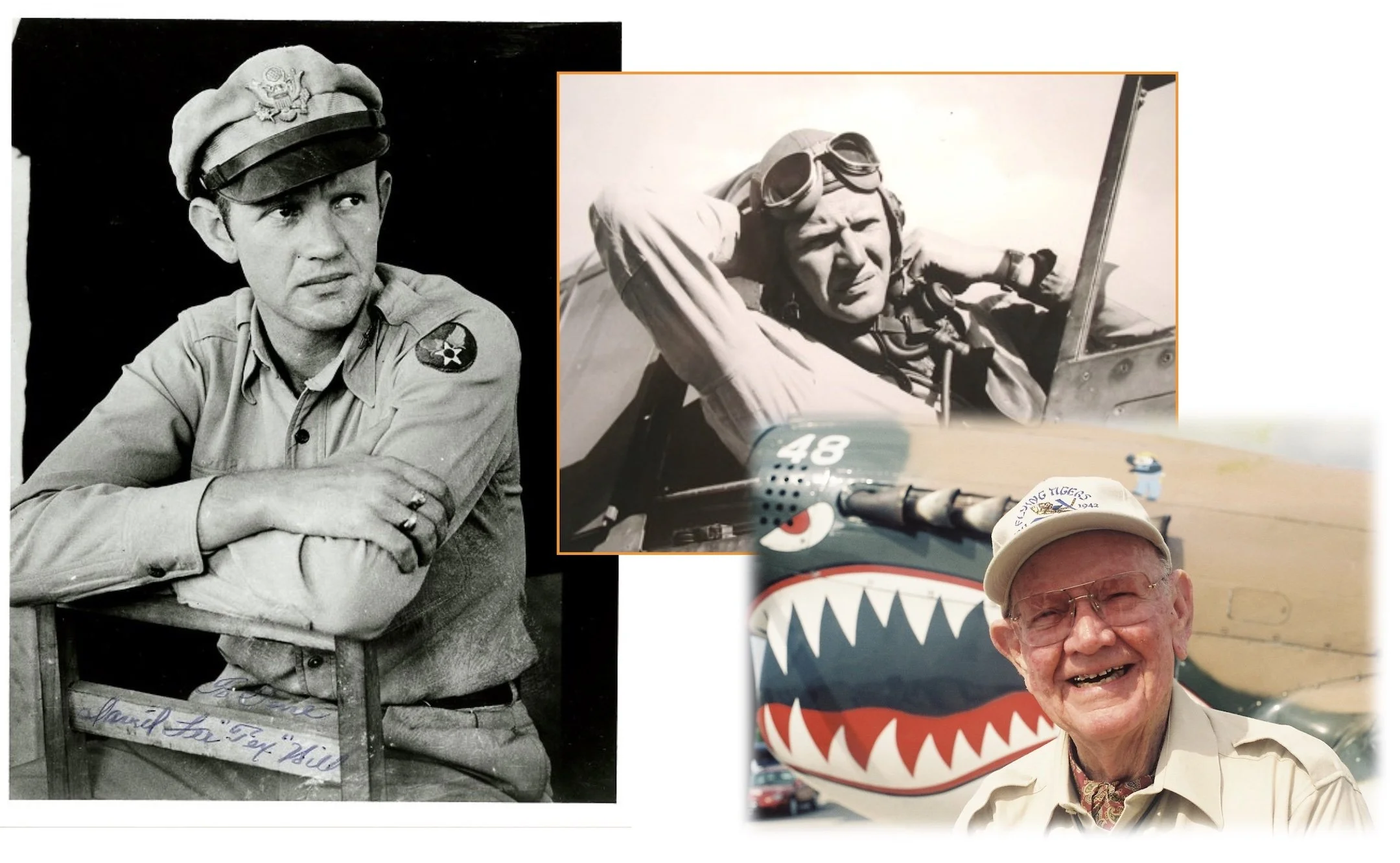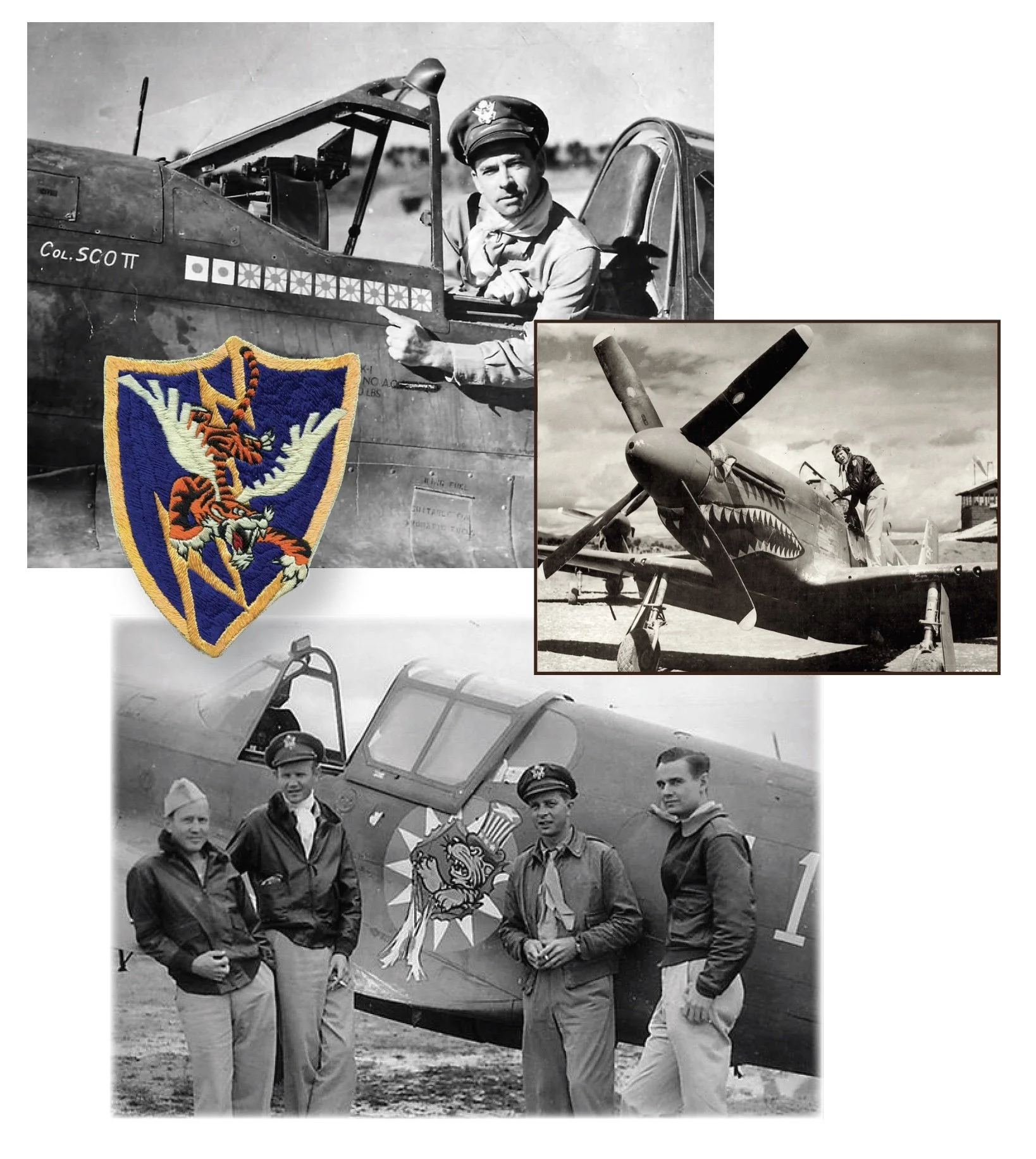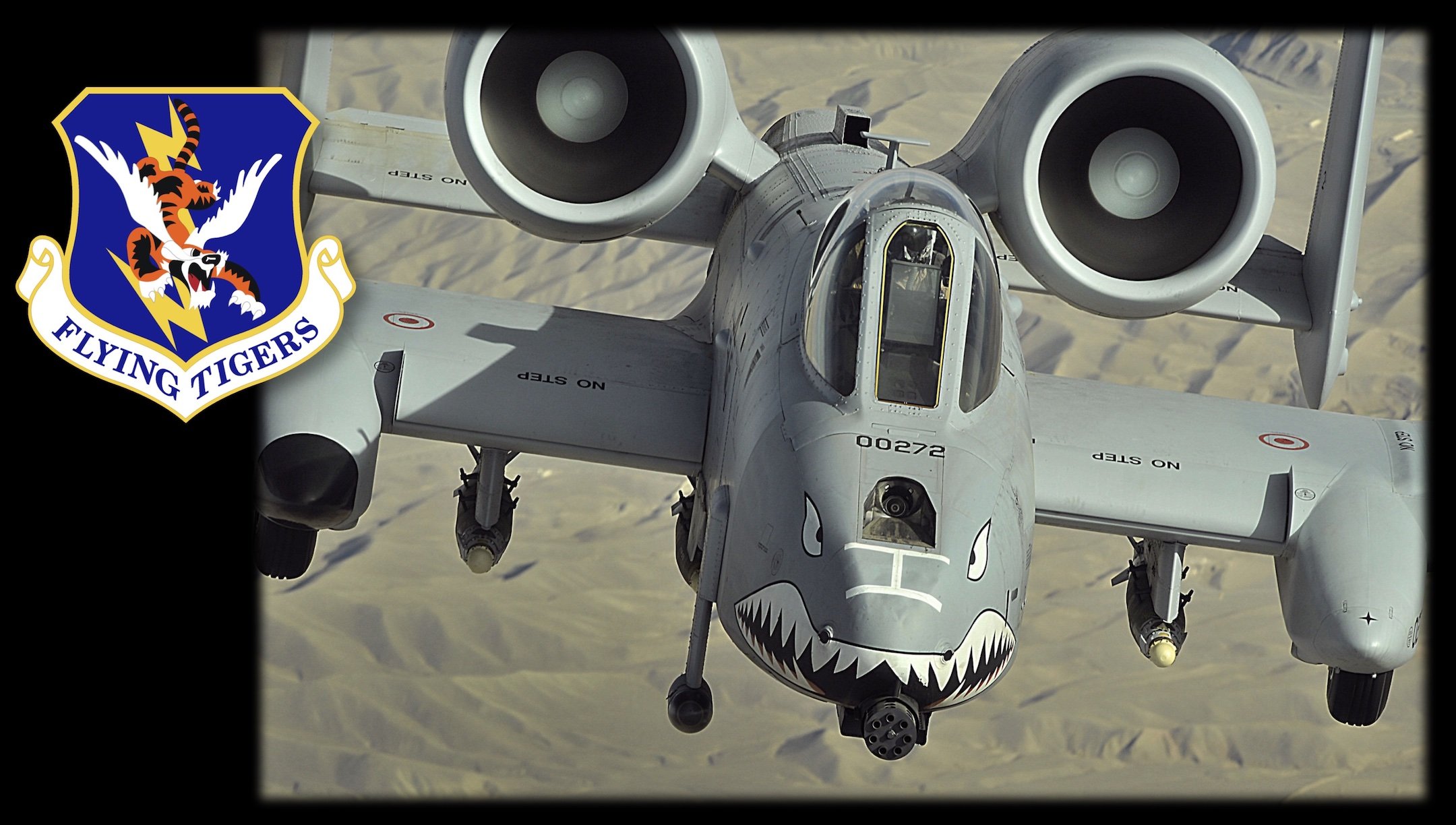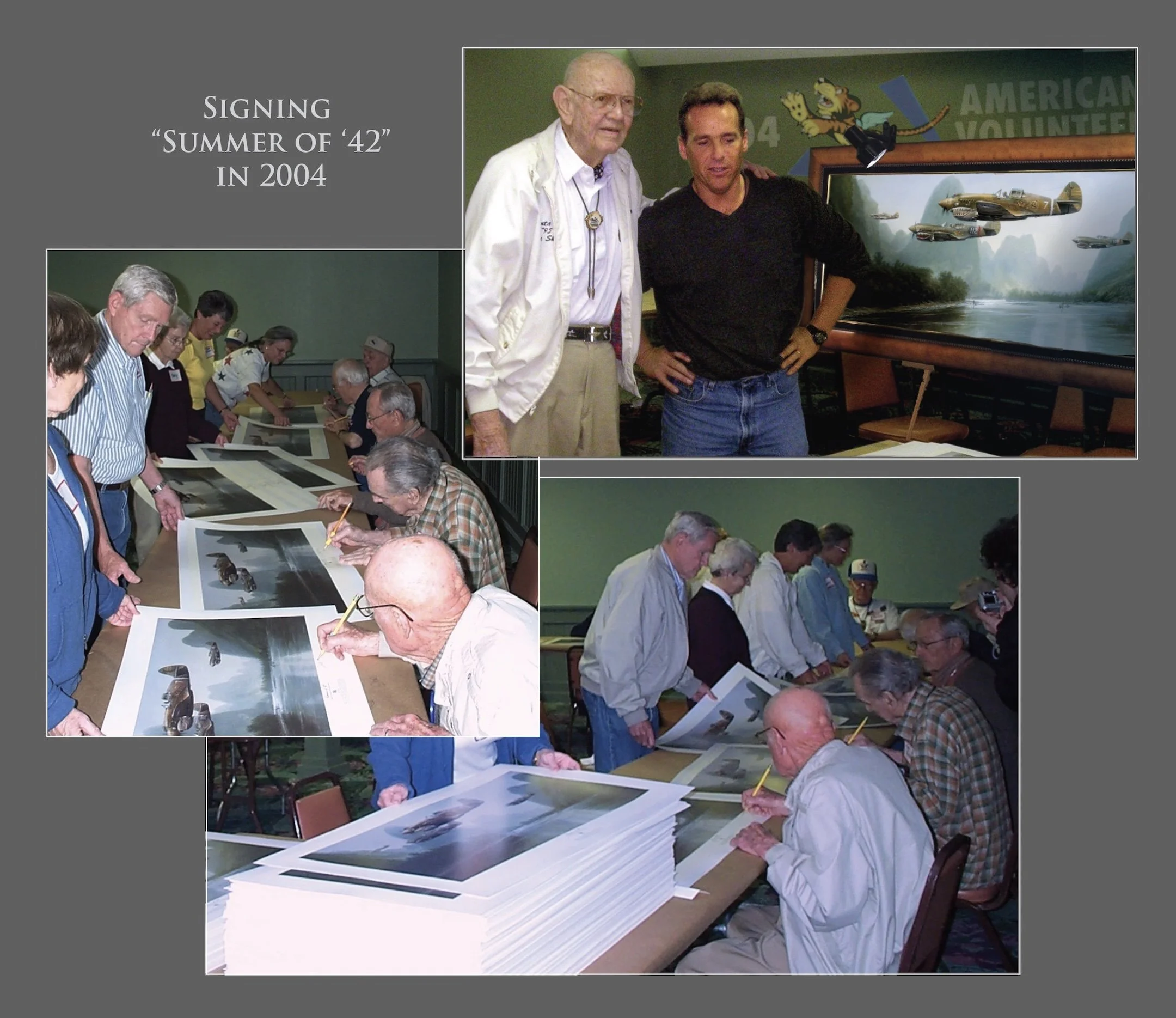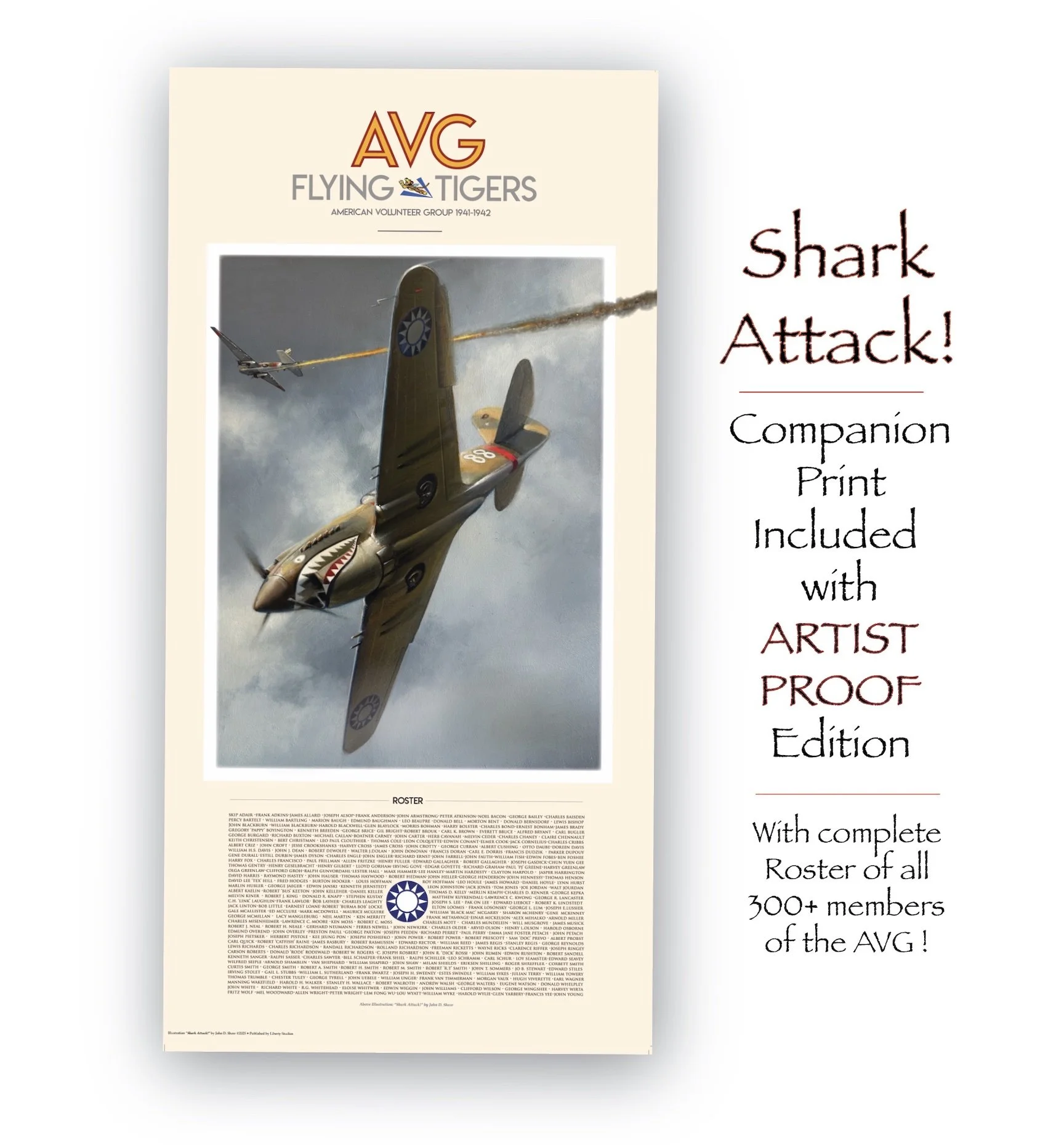FLYING TIGERS IN BURMA
The FLYING TIGERS- Who were they? Many people today don’t know! In this brief blog, I’d love to re-introduce them; As an artist who frequently uses the motto “Keeping History Alive” for his work, it’s my goal to play a part in not letting these great people be forgotten in the stream of time…
If the average person who isn’t necessarily into history thinks of anything related to the World War II era, one of the most familiar images which comes to mind is the old fighter plane shaped like a shark, its gaping mouth full of sharp teeth…American warriors flying planes, primitive by today’s standards, against an enemy on the other side of the world, before the days of radar, GPS, internet, etc…To many today, even the phrase “Flying Tigers” is either completely unknown or at best, vaguely familiar, and might as well be as distant in the past as soldiers who fought in 1776 or in the Civil War. But many people who were once part this incredible brave group were still among us as quiet neighbors just a short time ago! Behind the eyes of those distinguished, white-haired men and women, slow moving and bent with age, were living memories of days in which they shared in heroic adventures, fighting against tyranny in a unique group of patriotic mercenaries during one of the world’s darkest times.
For over three decades, it’s been a huge privilege to meet, work with, and in many cases form wonderful relationships with some of the legendary American Volunteer Group (AVG), many of whom became especially near & dear to my family and me. While introducing my new painting FLYING TIGERS IN BURMA, I hope to give a brief overview of the AVG to any who are unfamiliar, share some of our times together, and also tell a bit about the new painting…
Claire Lee Chennault, a seasoned U.S. Army Air Corps officer & aviation tactician, became the mastermind behind the formation of the Flying Tigers. In the late 1930s, after retiring from the Army due to health reasons, he was invited to China to help build and train the Chinese Air Force amid increasing Japanese aggression. Recognizing the need for better air defense, Chennault proposed the creation of an volunteer air group composed of experienced American pilots recruited from the U.S. military under civilian cover, with support from the Chinese government and clandestine backing from President Roosevelt. Pictured here with him is Madame Chiang Kai-shek, the wife of China’s leader, who played a significant diplomatic role acting as a bridge between China and the US. Along with Chennault, Madame Chiang was instrumental in garnering American support for China and was a key advocate for the Flying Tigers.
The primary initial mission of the AVG was to protect the Burma Road, the key supply route bringing war materials from British-controlled Burma into China. As Japan expanded its control across Southeast Asia during World War II, safeguarding this lifeline became critical to sustaining Chinese resistance. The AVG was to conduct aggressive aerial defense and interception missions against Japanese bombers and fighters targeting the road and its surrounding areas. Their efforts would play a critical role in keeping the supply line open during some of the war’s most desperate months.
In mid-1941, with Presidential approval, approximately 100 pilots and 200 support personnel were allowed to resign from their military services, volunteering to be “recruited” by the AVG. Enticed by the chance to travel to exotic foreign lands, better pay and (for pilots) the added bonus of an extra $500 bonus for every enemy plane they could knock down, they were soon off! With falsified travel papers, posing as civilian missionaries, artists, contractors- anything but military officers- the men and women of the AVG set sail for Burma aboard several several Dutch liners, such as the M.S. Jagersfontein, Java Pacific liner Bloemfontein and others. Few had any actual combat experience, and though war seemed a somewhat distant reality to them, in a short time they would be in the thick of desperate times, and be tested by fire they had never imagined- but they would more than rise to the occasion!
As the new “recruits” of the AVG arrived in Burma between July and late November 1941, they were grouped into three “Pursuit” squadrons- the 1st Pursuit Squadron called themselves the “Adam & Eves” (named for man’s first pursuit of Adam chasing Eve)-although on their apple insignia, they reversed the order of who was chasing who! The 2nd squadron became the “Panda Bears”, named after China’s beloved furry indigenous residents, and the 3rd squadron nicknamed themselves the “Hell’s Angels”, years before the infamous motorcycle gang would adopt the name.
In late 1941, the Flying Tigers began their initial training in Burma at Kyedaw airfield near Toungoo. The Curtiss P-40 was quite unfamiliar territory for nearly all pilots, and the realities of actual aerial combat were just as unfamiliar . Chennault had his hands more than full teaching tactics he believed would be effective against the more maneuverable, lighter-weight Japanese fighter aircraft. Pictured in lower left photo is ‘Tex’ Hill, during his introduction to the P-40. Prior to the AVG, he had been training as a Navy dive bomber pilot, and the Curtiss ‘Tomahawk’ was new territory. Tex’s fellow pilot Ed Rector recalled “that damn engine stuck out there so far, I thought if I step on the brakes, this thing is gonna tip over!” His assessment was not far off…approximately a dozen would be wrecked during training.
During their initial months, the AVG shared bases with RAF units who’d been equipped with American aircraft which were a bit more recent in the inventory than the P-40, allotted to British & Commonwealth allies through the US’s Lend-lease program. The Brewster”Buffalo” was the latest piece of aviation equipment which had previously arrived via lend-lease, and the AVG’s new allied counterparts were New Zealander pilots of the Royal Air Force’s No. 67 Squadron.
As the American newcomers became acquainted with their Kiwi counterparts, friendly rivalries soon became inevitable. In the early months during training before first entering combat, AVG pilots began suffering ribbing from the Buffalo pilots, who boasted at having a more ‘updated’ plane. Some would even raise doubts about the prowess of the ‘crusty old army captain’ in charge of the American volunteers. Chennault insisted that despite being ‘newer’, the Brewster was underpowered and inferior to the rugged P-40, especially if his pilots would employ his aggressive air tactics in combat. Chennault consistently drove home the point that the P-40 should not attempt conventional dogfighting with their nimble lightweight Japanese adversaries, but rather use altitude & diving speed from above to attack. Japanese fighters sacrificed armor protection for manueverablity, and as such were more vulnerable to the nose & wing guns of the P-40. Still, the new AVG pilots’ Kiwi peers continued to sew doubts. Disgruntled at hearing of his pilots’ eroding confidence, to prove his point, he arranged a friendly challenge to the RAF boys…A mock dogfight for all to see.
Chennault chose pilot Erik Shilling for this demonstration, and as everyone gathered to watch the aerial joust, his men were soon left with no doubt that the rugged Tomahawk was indeed the better choice to soon face the enemy in combat, and quickly learned their soon-to-be legendary leader's tactics were extremely effective! Pilot Charlie Bond wrote in his diary on the demonstration: "An RAF Brewster pilot & Shilling put on quite a dogfight show for all of us right over the base. Shilling whipped him soundly. We couldn't say much for the RAF pilot- he didn't strike us as a 'tiger’. Still, these exercises would serve as valuable opportunities to learn from each other, & refine their aerial combat skills.
Though initially outmatched in both numbers and aircraft performance, 67 Squadron would go on to conduct critical air defense missions over Burma, especially around Rangoon, providing cover for retreating Allied forces and engaging Japanese bombers and fighters. Despite heavy losses and difficult conditions, the squadron helped delay the Japanese advance, buying time for Allied reorganization. They would later go on to be re-equipped with better fighters, including Hawker Hurricanes, and later after regrouping in India, the great Supermarine Spitfire. 67 Squadron continued supporting Allied ground forces with fighter-bomber operations until the war’s end, establishing itself as a unit of distinction.
The AVG’s first combat in late December 1941 resulted in a stunning victory over Japanese bomber attacking Kunming, setting the tone for their legendary combat record. This initial combat, during which Chinese civilians below witnessed the approaching Japanese bombers who’d frequently terrorized them mercilessly and unopposed over many months, suddenly plummet from the skies, under the guns of fast, strange new fighters with snarling shark faces painted on their noses! Wild celebrations of their new American rescuers broke out, and they described their defenders with the nickname "Fei Hu" or "Flying Tigers". The Tigers from then on would defend key positions, including Rangoon, from relentless Japanese attacks. Despite being vastly outnumbered, they delayed the Japanese advance for weeks. However, as Japanese forces pressed southward through Burma, the AVG was eventually forced to retreat. They evacuated Burma by early March 1942, relocating their operations entirely into China after the fall of Rangoon and other strategic points.
Over the course of the months following their initial combat, the Flying Tigers quickly became media sensations, heralded in American newspapers and newsreels as heroic underdogs taking on Axis aggression. Their exploits were romanticized in magazines like LIFE and dramatized in Hollywood films, including the 1942 movie Flying Tigers, starring John Wayne. The shark-mouth design on their aircraft became an iconic symbol of resistance and bravery, and their image was used in war bond drives and recruiting campaigns. Globally, the Flying Tigers symbolized American ingenuity and courage, and they helped galvanize public support for the Allied cause, particularly in the critical early phase of the Pacific War.
During their relatively brief time as a unit in the early months of World War II, the AVG would ultimately receive credit for approximately 300 enemy aircraft destroyed, and roughly one fourth of their pilots would earn the distinction of becoming Fighter Aces, scoring five or more victories. One particularly notable example was David Lee “Tex” Hill. Assigned to the 2nd ‘Panda Bears’ squadron, Tex quickly proved his exceptional leadership and combat skills. As a flight leader and later squadron leader, he led numerous significant missions, including stopping advancing Japanese forces in the harrowing Salween River Gorge, which some historians believe would likely have caused China’s surrender. Tex was also known for his inspiring leadership, bravery, and tactical acumen. His pilots respected him not only for his flying abilities but for his ability to remain calm under pressure, often in situations that seemed hopeless.
By mid-1942, WWII had quickly progressed into full swing for the US, and the decision was made to disband the AVG on July 4, 1942. At that time, their personnel were given the choice by the US Army Air Corps either to immediately re-enlist in the newly-formed 23rd Fighter Group, or otherwise “find their own way back home”. This understandably frustrated most of its veterans , who simply wanted a short period of leave after serving in harm’s way valiantly over the better part of the past year. Most did leave, and went on to serve in other distinguished military services for the duration of the war; Some AVG members volunteered to stay an extra 2 weeks to help the new arriving 23rd pilots learn the ropes. A few other pilots, fiercely dedicated to Chennault, decided to stay on with the 23rd, swapping their well-worn AVG “uniforms” for new US Army Air Corps uniforms.
The new incoming 23rd commander was Robert L. Scott (pictured above, top), An admirer of Tex Hill’s combat experience, he quickly assigned the Panda Bears’ squadron leader as commander of the 23rd’s 75th Fighter Squadron. (Scott has a great intro to Tex in his famous book God is my Co-Pilot).
Initially equipped with P-40s, the 23rd would eventually be equipped with newer aircraft, such as the P-51 Mustang (Tex pictured above in one, still adorned with the familiar shark teeth). The 23rd would continue to carry the name ‘Flying Tigers’ throughout the rest of the war, serving with great distinction and carrying on the legacy established by the AVG.
The heritage of the original AVG Flying Tigers certainly did not end with World War II…The 23rd would go on serving in Korea, Vietnam, Cold War, Middle East conflicts and on… Today, based at Moody Air Force Base, mighty A-10 “Warthogs” of the 23rd wing continue to sport the Shark Teeth originally applied to their 1941 predecessors. At present, the 23rd has plans in the very near future to replace these great aircraft with F-35 Lightnings. (Yep! They will have the teeth as well!)
PAINTING THE FLYING TIGERS!
Since the time I was very young, the sight of those AVG P-40s were a thing of excitement. As a pre-teen kid, I remember doing a pen & ink drawing of one for my dad, who, as a Navy WWII vet, remembered them vividly. He displayed my primitive drawing in his office for many years, and was as excited as I was when I first had the chance to meet and work with original AVG members in the mid-90s. Since 1995, it’s been a thrill and privilege to create a number of paintings, all of which were printed as lithographs, and autographed by many of these great heroes. Many of these prints sold out over the years, and have become valuable collector’s items among fellow admirers of the Flying Tigers. What an honor to keep their history alive through art!
So many great memories of getting together with AVG veterans & their families over the years, and the stories we’d hear as they’d autograph prints….!!! Here’s a group shot from 2002 at Randolph AFB in Texas, as we presented the base with a newly-signed print of Tigers in the Gorge.
Another cool moment in 2004- During the AVG’s reunion in Orlando, Florida, noted aviation enthusiast, pilot, and aircraft collector Kermit Weeks rolled out the red carpet for the vets at his great Fantasy of Flight Museum near Lakeland, Florida. Kermit was the proud owner of the only existing original P-40 Trainer, in mint flying condition, and on a Saturday afternoon gave five AVG pilots the chance to take a hop into the Florida skies, letting them once take the controls of their faithful old Warhawk once again for the first time in half a century…What a great time for them!
Afterwards, he had the P-40 seat removed and autographed by his five co-pilots. That evening he hosted a dinner and shared the fun moment with all of us in the adoring crowd. Pictured here with Kermit are pilots Dick Rossi, Charlie Bond, Tex Hill, Bob Layher and Peter Wright.
The last time a group of multiple AVG veterans were able to gather to sign a lithograph print edition was in Charleston, South Carolina. There, eleven of them shared memories and stories as they signed prints of my painting Shark Sighting. Shown here are Tex Hill, Chuck Baisden and Dick Rossi seated in front of the large original oil painting. (Note: in this painting, Tex is the pilot facing us, looking over the shoulder of armorer Chuck, seated in the cockpit testing the guns)
NEW in 2025- Flying Tigers in Burma
This year, on the 4th of July, to commemorate the anniversary of the conclusion of the AVG, we made the announcement of a NEW painting of an unusual phase AVG History- FLYING TIGERS IN BURMA. This new painting also has given us one last chance to offer a new prints with lots of original AVG autographs- a chance to continue their legacy with their actual hand-written signatures!
But only a few… How was this possible?
In 2004, I’d completed the painting Summer of ’42 and a print was produced, which a group of about 18 AVG veterans signed during their reunion in Orlando, Florida. During the labor-intensive process of autographing over 1000 prints, many fun moments and memories are heard, and afterward, all signers and helpers share a great sense of accomplishment. (In the photo, Yours Truly is standing with Tex in front of the oil painting, and the lower two pics show the signing ‘assembly line’).
After one of these sessions, the process of signing, numbering and sorting the autographed prints by the artist begins. Unfortunately, as is common in a large run, there are inevitably a small number of lithos which may have been printed with a flaw in the image- an inconsistent variation in color, an unwanted ink spot in the image, or other flaw which ordinarily would cause it to be pulled out before going thru the signing line; in the case of Summer of ’42, there wasn’t time to do this before the session, so when all was said and done, a small batch of 30-plus slightly misprinted but signed lithographs were pulled out of the numbered edition and set aside.
Ordinarily, they would be discarded, but it would have been a crime to discard autographs which could potentially continue the legacy & history of these great WWII heroes. I had ideas for these down the road, so later that year, I took these signed prints to the homes of a few other AVG members who weren’t present at the Orlando reunion for their signatures as well. Most of these wound up with a total of 22 great AVG signatures in all!
So the batch was sealed up and placed in storage for the past couple of decades, awaiting a hopeful new life one day…
Fast forward to recently…
I conspired with one of my favorite people, Mr. Mark Davis, Executive VP of Perform Air International, based in the Phoenix, AZ area, to do a series of military aviation paintings for his company- Over the years, Mark had commissioned a number of my previous WWII paintings, and as a fellow kindred spirit for the history and heritage of these heroes of the past, he and I agreed that one of the new paintings’ subjects should definitely include the Flying Tigers!
After batting around several concepts, Mark suggested the idea of doing a scene which highlighted an often overlooked period of the AVG’s early months when they were based in Burma with Brewster Buffalos of the RAF’s 67 Squadron. Last year, Mark traveled to Florida, where we unveiled the painting for the first time in a presentation during my ‘Wings of History’ exhibit at Daytona Beach’s Museum of Arts & Sciences. (For more, please see the VIDEO at the end of this blog post).
Not only was a new print going to be released, but a VERY special edition would also be created, utilizing the previously-signed 2004 lithos.
For the very limited number of stored lithographs from 2004, a beautiful archival paper giclée overlay of Flying Tigers in Burma was created to permanently affix over those misprinted Summer of ’42’s, along a brass title plate with the new painting’s name replacing the old printed title. Best of all, these rare prints bear ALL 22 AVG signatures. Only a total of 30 of these special SIGNATURE EDITION prints exist, and nearly all have sold since its 4th of July announcement.
(As of this post, we have a very small handful left!)
Here are the great AVG veterans whose names appear on the Signature Edition; All three AVG squadrons are represented, making this a valuable piece of history…
Top Row: Charlie Bond, Joe Rosbert, Carl Brown, Tex Hill, Robert ‘Bus’ Keeton, Bob Layher
Middle Row: Dick Rossi, Frank Anderson, Charlie Mott, Ken Jernstedt, Morgan Vaux, Peter Wright, Emma Jane ‘Red’ Foster, P.J. Greene
Bottom Row: Keith Christensen, Joe Poshefko, Ed Janski, Frank Losonsky, Paul Clouthier, Ed Stiles, Chuck Baisden, Leo Schramm
—With these prints, we’ve created a Certificate / booklet with biographies of each, along with photos from WWII and during 2004 when they autographed.
There are 300 ‘Main Edition’ prints and 100 Artist Proofs, signed & numbered by the artist- each includes an informative Certificate of Authenticity.
With the 100 Artist Proofs, an extra Companion print is also included.
Beneath the vintage-style illustration entitled Shark Attack! is a complete roster of every member of the original American Volunteer Group- There were over 300 people altogether…Some rosters don’t include various individuals who’d left the AVG before their disbandment (“Pappy” Boyington, for one!), but in cross-referencing other official historic documents and rosters, this one includes everyone who was ever a member of the AVG.
The story of the Flying Tigers is one of courage, innovation, and the indomitable human spirit. These American volunteers, flying in a distant land under difficult circumstances, became legends not just for their victories in the air, but for their role in forging a bond between the United States and China that endures to this day. As we look back on their contributions, we honor the bravery of the Flying Tigers and the enduring legacy they left behind.
The original painting FLYING TIGERS in BURMA is unveiled, January 2024 during John’s “Wings of History” art exhibit at the Museum of Arts & Sciences Daytona Beach. Mark Davis, who commissioned the painting for his company Perform Air International, traveled to Florida where he and John discuss the painting during an auditorium presentation. This is a brief portion filmed from an audience member’s iPhone- (video resolution not great, but interesting to hear discussion!)
YouTube link: https://www.youtube.com/watch?v=GuOrGHELVYQ
To Purchase: https://www.johnshawart.com/artwork/p/flying-tigers-in-burma




